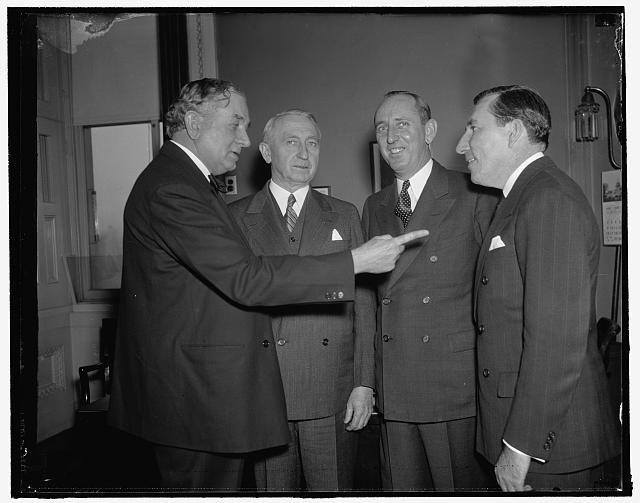Confronting the anti-civil rights filibuster

Members of the group of Southern senators who filibustered anti-lynching legislation in 1938. Left to right: Tom Connally of Texas, Walter F. George and Richard Russell of Georgia, and Claude Pepper of Florida. (Image via Library of Congress)
Congressional Democrats have set forth a bold agenda that includes legislation to tackle climate change, raise the minimum wage to $15, and expand voting rights — all of which would overwhelmingly benefit Black Americans as a whole and communities of color across the South.
But standing in the way of the Democrats' agenda in the evenly divided Senate is the filibuster, a parliamentary procedure that increases the number of votes required to pass legislation in the Senate to 60 instead of the usual simple majority of 51. The filibuster gives the minority party the ability to impede the legislative process, and it has a long history of being used to block civil and voting rights bills. And although some current legislative proposals might be able to gain more bipartisan support, others are already facing fierce opposition from Republicans, including the democracy-expanding For the People Act and the John Lewis Voting Rights Advancement Act.
Democratic senators have endorsed making changes to the filibuster in order to move Biden's agenda forward. "We just can't wait two years to get things done," said Sen. Amy Klobuchar, a Minnesota moderate who recently joined the push. Even conservative Democratic Sen. Joe Manchin of West Virginia, who initially promised to leave the filibuster untouched, has said he is open to changes. "The filibuster should be painful, it really should be painful and we've made it more comfortable over the years," he said, referring to the so-called "talking filibuster," when the rules required filibustering senators to hold the floor with lengthy speeches. In an interview with ABC News, President Biden also endorsed bringing back the talking filibuster.
"It's getting to the point where democracy is having a hard time functioning," he said.
Critics of the filibuster point to its racist roots. In a eulogy for civil rights icon U.S. Rep. John Lewis of Georgia delivered last summer, former President Barack Obama called the practice a "Jim Crow relic." And U.S. Sen. Elizabeth Warren of Massachusetts has pointed out that the filibuster "was designed to give the South the ability to veto any effective civil rights legislation or anti-lynching legislation." The word itself is derived from a Dutch term for pirates and came to mean going rogue and disrupting the government.
Gregory Koger, a University of Miami political scientist who specializes in Congress, told Politifact that the filibuster's reputation as racist "dates back to the pre-Civil War era, when the legislative tactic was used to block the admission of states based on their slavery status." Later during the Reconstruction and post-Reconstruction eras, senators used the filibuster to block major civil rights legislation, including "measures to prohibit lynching, poll taxes, and race discrimination in employment, housing, public accommodations, and voting," as legal scholars Catherine Fisk and Erwin Chemerinsky wrote in a history of the filibuster published in the Stanford Law Review in 1997.
The first modern filibusters became a powerful tool for defending white supremacy and undermining racial progress. Political scientist Sarah Binder notes that of the 30 measures that were filibustered between 1917 and 1994, exactly half dealt with civil rights.
For example, in 1922 the U.S. House passed an anti-lynching bill introduced by Rep. Leonidas Dyer, a Missouri Republican and civil rights activist. The measure would have given the federal government the power to prosecute private citizens who participated in lynchings and fine counties that failed to prevent the violence. Despite substantial support from congressional lawmakers and President Warren G. Harding, the bill failed because of filibuster led by Southern Democrats.
In 1935, Congress tried again to pass anti-lynching legislation, but Sen. Richard Russell Jr., a Georgia Democrat, held a six-day filibuster to oppose it. During the proceedings Russell said that he was "willing to go as far and make as great a sacrifice to preserve and insure white supremacy in the social, economic, and political life of our state as any man who lives within her borders." Three years later, Southern senators again blocked an anti-lynching bill with a 30-day filibuster.
And in the 1940s Southern Democrats used the filibuster to prevent debate over the civil rights proposals introduced by President Harry Truman. These early uses of the filibuster set the stage for the obstruction of key civil rights legislation in the 1950s and 1960s.
Segregationist Sen. Strom Thurmond of South Carolina filibustered the Civil Rights Act of 1957, which had substantial bipartisan support and included protections of voting rights for Black Americans. Thurmond spoke for a record 24 hours and 18 minutes to prevent the passage of the bill. The version of the act that eventually made it through the Senate was significantly weakened, lacking critical enforcement provisions.
Perhaps the most high-profile use of the filibuster was against the Civil Rights Act of 1964 by a group of Southern senators, with millions of Americans watching the proceedings live on TV. Leading the effort were Sens. Russell, Thurmond, Robert Byrd of West Virginia, Sam Ervin of North Carolina, and William Fulbright of Arkansas. Russell started the filibuster in March 1964, and it lasted for 54 days. It was ended by a rare cloture vote, which at the time required the agreement of two-thirds of members. (The cloture rules were eased in 1975 to require votes from only three-fifths of members.)
In recent years Republican lawmakers have used or threaten to use the filibuster to try to block major legislation including the DREAM Act, the Affordable Care Act, and proposals for gun reform.
The Brennan Center notes that the Senate's productivity has declined because of the filibuster, not only in terms of the total number of bills passed but also bills passed as a percentage of bills introduced. In 1947, as far back as official records go, the Senate passed just over 52% of bills introduced. By 1972, that number dropped to just over 11%. By 2020, the Senate passed just under 4% of bills introduced.
"The ability of a small group to derail legislative action has prevented senators from working across party lines to engage in bipartisan deliberation and policymaking," wrote Caroline Fredrickson a senior fellow with the Brennan Center. "Without reform, if not abolition, of this rule, advocates for democracy will not be able to move their agenda into action."
Among the filibuster reform proposals that have been put forth are shifting the burden to the minority by requiring it to sustain debate with 40 votes, reducing the number of votes required to end debate, and requiring filibustering senators to hold the floor with speeches.
Republicans, however, are staunchly opposed to filibuster reforms, with Senate Minority Leader Mitch McConnell of Kentucky threatening a "scorched-earth Senate" if members vote to end the procedure — even though as majority leader McConnell eliminated the filibuster to get President Trump's Supreme Court nominees confirmed. Ending the filibuster would take 51 votes, which Democrats do not currently have.
But this week Democrats unveiled a strategy to pressure Republicans on the filibuster by forcing them to openly state their opposition to popular policy proposals and show hesitant lawmakers that gridlock will continue if the Senate tradition is not altered. Democratic Sen. Tim Kaine of Virginia has pointed to several pieces of legislation that already have widespread support across the country but face Republican opposition.
"If Dems are all fine, then we'll bring them up on the floor and see if we can get Republican support," Kaine said. "I think that's probably the next step."
Tags
Benjamin Barber
Benjamin Barber is the democracy program coordinator at the Institute for Southern Studies.
